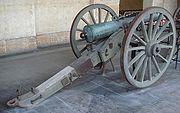
Valée system
Encyclopedia

Sylvain Charles Valée
Sylvain-Charles, comte Valée , born in Brienne-le-Château, was a Marshal of France.Upon the outbreak of the French Revolution, Valée enlisted in the French revolutionary army and was sent to serve in the Army of the Nord...
, and officially adopted by the French Army from 1828.
Specifications


Napoleon I
Napoleon Bonaparte was a French military and political leader during the latter stages of the French Revolution.As Napoleon I, he was Emperor of the French from 1804 to 1815...
's Year XI system
Year XI system
The Year XI system was a French artillery system developed during the rule of Napoléon I. The Year XI system was original in that it brought various improvements to the highly successful Gribeauval system, on which many successes of the Napoleonic Wars relied...
. The system mainly improved the mobility of the artillery train, and simplified maintenance by standardizing limber usage and wheel size, and reducing the number of carriage types to two. It also allowed for cannoniers to be able to sit on the ammunition chests of the battery itself during transportation, allowing the whole artillery train to move as fast as the infantry or cavalry.
Valée also improved the guns themselves slightly, by making them lighter, and with a longer range.
The complete Valée system consisted in siege guns of 24 and 16 pounds (French pounds), and field guns of 12 and 8 pounds. It also included field howitzers of 24 pounds and 6 inches (Obusier de 15 cm
Obusier de 15 cm Valée
The Obusier de 15 cm Valée, was a French Artillery 6-inches howitzer belonging to the Valée system of artillery developed between 1825 to 1831 by the French artillery officer Sylvain Charles Valée.-Specifications:...
), and a siege howitzer of 8 inches. Mountain artillery pieces were of 12 pound caliber. Mortars were of 12, 10 and 8 inches, with a 15 inches stone mortar.
Deployment


Invasion of Algiers in 1830
The Invasion of Algiers in 1830 was a large-scale military operation by which the Kingdom of France, ruled by Charles X, invaded and conquered the Ottoman Regency of Algiers...
(1830) and the Fall of Constantine (1837), as well as during the Crimea War (1853-1856).
An American version of the Valee system was also developed. Some pieces are visible at the Concord Battery, Concord, Massachusetts
Concord, Massachusetts
Concord is a town in Middlesex County, Massachusetts, in the United States. As of the 2010 census, the town population was 17,668. Although a small town, Concord is noted for its leading roles in American history and literature.-History:...
.
A new generation of weapons would emerge in shell
Shotgun shell
A shotgun shell is a self-contained cartridge loaded with lead shot or shotgun slug designed to be fired from a shotgun....
-firing canon obusier
Canon obusier
The Canon-obusier was a type of cannon developed by France in the 1850s. The canon-obusier was a smoothbore cannon using either shells, balls or canisters, and was therefore a vast improvement over previous cannon firing metal balls, such as the Gribeauval system.The very first canon-obusiers...
s, with the invention of the naval shell-gun by Paixhans in 1823, and the introduction of the canon obusier de 12
Canon obusier de 12
The Canon obusier de 12 , also known as the "Canon de l’Empereur" was a type of canon-obusier developed by France in 1853...
in 1853 by the French Army
French Army
The French Army, officially the Armée de Terre , is the land-based and largest component of the French Armed Forces.As of 2010, the army employs 123,100 regulars, 18,350 part-time reservists and 7,700 Legionnaires. All soldiers are professionals, following the suspension of conscription, voted in...
, which would render the Valée system system obsolete.

